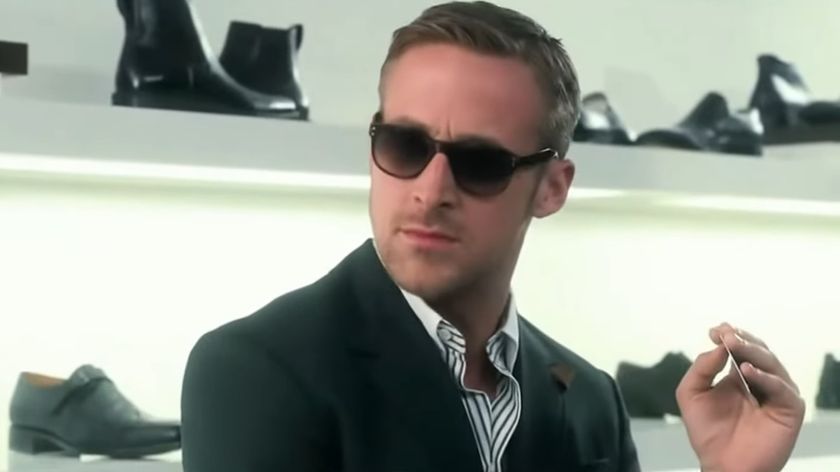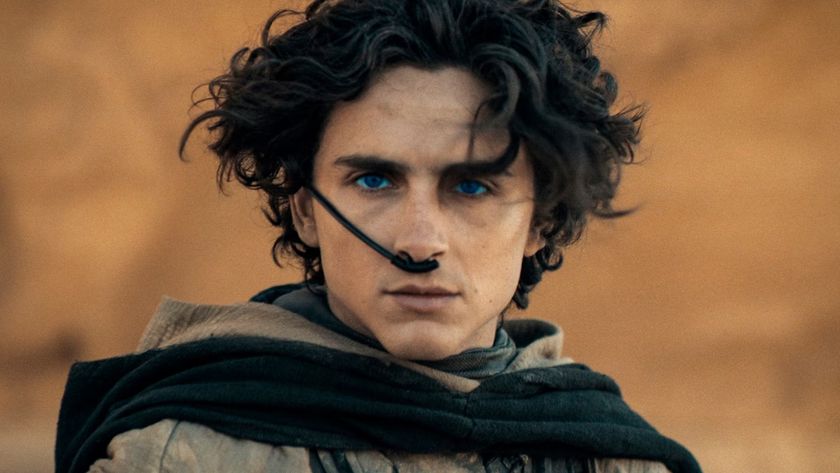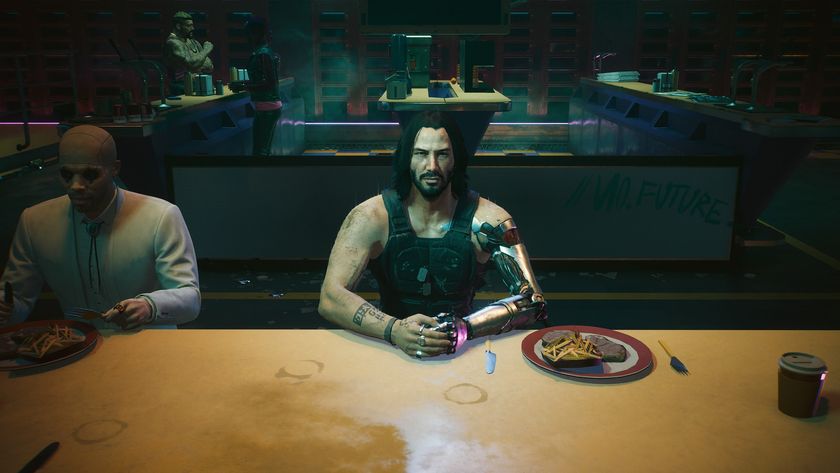Gareth Edwards and John David Washington talk new sci-fi epic The Creator
Gareth Edwards and star John David Washington tell Total Film how this huge spectacle was shot guerrilla-style and concentrates on emotions as much as large-scale action
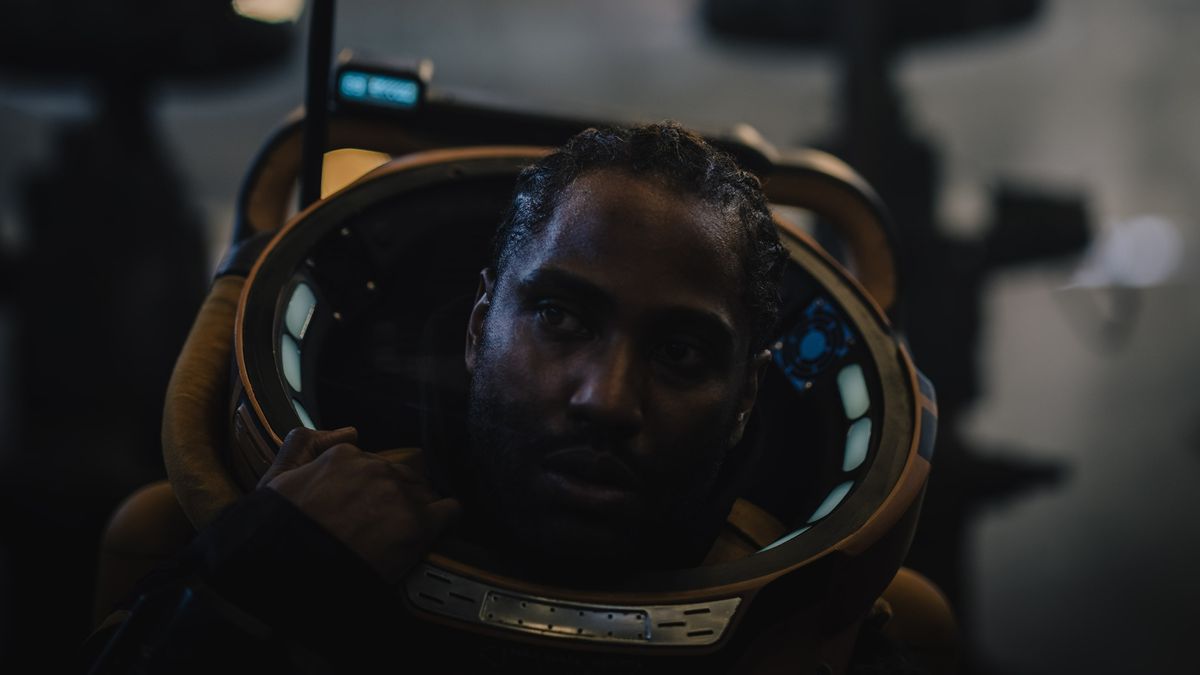
This article first appeared in the August 2023 issue of Total Film magazine. You can purchase a hard copy here.
When Gareth Edwards is not making science-fiction films – and what science-fiction films, his first three movies being Monsters, Godzilla and arguably the best Star Wars movie this side of the original trilogy, Rogue One – he likes to annoy family and friends with dilemmas. ‘I love being like, “Ah, imagine if…” and, “What would you do if…”,’ he grins over Zoom from his LA base (‘I can’t bring myself to say I live in LA, not to a fellow Brit’), explaining that the best scenarios are those that offer no easy way out. Like, ‘If you could go back in time and kill Hitler, but the catch is, he’s an innocent, four-yearold kid, could you do it?’
And so he arrived at the ethical dilemma that occupies the heart of his new science-fiction action drama, The Creator. The year is 2070. AI has detonated a nuclear warhead on Los Angeles, sparking all-out war. And John David Washington’s ex-specialforces agent Joshua has gone into New Asia (‘It’s what we call a collection of countries in Southeast Asia, where this war is going on,’ explains Edwards) and located the ultimate AI weapon… which turns out to be a child, played by newcomer Madeleine Yuna Voyles. ‘Execute her, or we go extinct,’ Joshua is told, as seen in the skin-prickling trailer. But can he do it? Edwards’ grin is widening. ‘For humans to win the war and survive, all they have to do is destroy this advanced AI. This weapon is the first AI that will surpass humans. Everything else in our movie is equal to humans – like, the same, basically copy-and-paste. But she is this new thing, the singularity, that will change everything. [Humans] want this technology destroyed. And then they basically find out that it’s this six-year-old girl, and it all goes wrong from there. Obviously the journey for John David’s character is just that constant knowledge of, “I’m going to have to kill this thing at some point,” as he travels with this kid, and how that starts to affect him.’
Some viewers of the trailer excitedly tweeted that The Creator looks like Edwards’ Terminator 2: Judgment Day – war against AI, a nuke, a child under threat. But Edwards, a huge fan of James Cameron (‘I grew up watching his films to death’), gently quashes those theories, saying the trailer communicates the first few minutes of The Creator; the movie takes different turns from there. More of an influence, he says, is Stephen Frears’ 1984 thriller The Hit, in which a couple of criminals played by John Hurt and Tim Roth capture on-the-lam ex-crim Terence Stamp, who ratted out his crew 10 years ago. They’re assigned to drive him across Spain and France, to Paris, to meet his fate, but form a bond en route. Likewise Joshua and Alphie, as our hero calls the child (the weapon’s codename is Alpha Omega), but with cutting-edge complexities layered on top. ‘Are you jeopardising the future of humanity because of a trick?’ asks Edwards, pondering the philosophical question du jour: can AI simply replicate emotions, or is it possible to evolve to a state of actual feelings? ‘Like, “This isn’t real; this is just a laptop, just turn it off.” You know what I mean? That is kind of what the movie is about. There are all those questions.’ Edwards offers his biggest grin yet. ‘And there’s no easy answer.’
World population
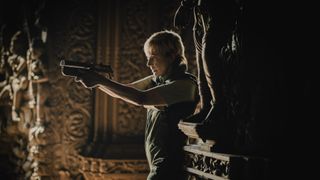
When Edwards first met Washington, at the Polo Lounge in Beverly Hills (‘Our agents picked it,’ he says, embarrassed that it sounds fancy schmancy), he thought the star of BlacKkKlansman, Malcolm & Marie and Tenet was ‘taking the piss’. ‘I had a Star Wars COVID mask that I wore to meet him,’ laughs Washington, son of Denzel, who’s today dressed down in a plain black T-shirt. ‘It was probably over the top but I’m really just a geek for Star Wars. I was going berserk [when I saw Rogue One]. I couldn’t believe what I was seeing – and obviously how it ends, and how it connected with the originals, which are my favourites.’ The meet was meant to be a quick one, but they hit it off and chatted for three hours. ‘A really kind soul’ is how Edwards describes Washington, while the actor calls the filmmaker ‘zen’, and refers to the ‘tranquillity’ of their meet. Driving home, Edwards recalls that, ‘I’d pass billboard after billboard after billboard of J.D. just looking at me, pointing a gun.’ Tenet was in cinemas; and Washington, by the time Edwards got in the front door, was in The Creator.
Similarly painless was the casting of Voyles as Alphie. From the hundreds of audition tapes sent in during the pandemic, Voyles, who lives in San Diego and is of Southeast Asian descent, was the first hopeful to meet with Edwards in person. He took her and her folks around the Universal theme park (‘So I could check the family was stable and cool – we were going to have to spend five months with these people, in the middle of nowhere’) and she nailed the emotional scene she’d been asked to prepare. Then she nailed another, this time with no forewarning. ‘I got paranoid that maybe her mum had prepped her really, really well, and she’d come in like a loaded gun, ready to do an emotional scene,’ says Edwards. ‘So I said, “Do you want to play a new idea?” We did this other thing that was also very emotional. It was heartbreaking to watch. As soon as she left, we just looked at each other, and were like, “Why do we need to carry on the auditions? This is it, right?”’
In other key roles are Gemma Chan and Ken Watanabe, the former no stranger to AI dramas having starred as servile ‘synth’ Mia in hit C4 series Humans, and the latter no stranger to Edwards given his role as Monarch biologist Dr. Ishir Serizawa in Godzilla. Edwards details their roles in the drama, but to do so necessitates the dropping of spoilers. Total Film assures him that said spoilers will not be passed on to readers. So of Watanabe’s Harun we’ll say nothing, and for Chan’s Maya, let’s leave it at this: she’s Joshua’s missing wife, for whom he is grieving. ‘He’s a tormented man, a man who’s lost everything, a man who’s seeking redemption,’ explains Washington, stressing how important it was to him that The Creator integrates ‘the humanity, the feelings, the emotions’ with the spectacle. ‘He’s a man caught in between worlds. A man who’s dealt with discrimination. He didn’t quite fit in because of his Papua New Guinea bloodline. He wasn’t necessarily American enough, or Black enough. And I don’t want to give it away, but…’ He does give it away; it won’t be repeated here. ‘So there’s all these interesting ways to view Joshua, when I think about what he’s lost, and what he’s had to overcome, and what he deals with, being a soldier, and fighting for his country, and doing the right things,’ he concludes.
Sign up for the Total Film Newsletter
Bringing all the latest movie news, features, and reviews to your inbox
Robot wars
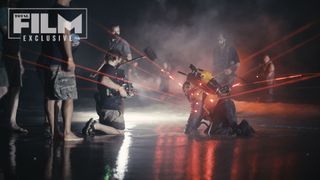
When Edwards and his co-writer Chris Weitz (Rogue One, The Golden Compass) started work on The Creator in 2020, they had little idea that AI would be such a talking point as their movie prepared to land in 2023. Certainly, AI has featured in numerous sci-fi films and shows before (see feature on p44 for some prime examples), going back decades, but this year has seen an explosion in the public consciousness, with ChatGPT now a water-cooler conversation. ‘It was a total fluke,’ shrugs Edwards. ‘When we started, the AI in the movie was really an allegory for people who are different. But obviously I love science fiction, and I think the best science fiction has meat on the bone. It’ll explore ideas. It’s usually able to explore things that other genres can’t go to in quite the same extreme. And so as soon as you start to have anything AI in your storyline, the questions that come up really quickly are superfascinating: are they real? How would you ever know? Does it matter? What happens if you want to turn them off? Do they want to be turned off?’
During filming, while Edwards was driving to set in the middle of a jungle (more on the far-flung locations later), he was sent a link of a journalist having a conversation with an AI. Just like the rest of us, he was blown away by the ‘shockingly real responses from a non-human’. ‘The movie started as far-off philosophical questions that I might not live to see happen in my lifetime, and then suddenly, as we were filming, those news stories broke about people that are working with AI and feeling that they might be conscious, and things like this.’ Washington says that The Creator finds time to dig deep into the philosophical quandaries. The action is set at a time when humans and AI are fully integrated, and the actor shares some of Joshua’s backstory with Total Film, explaining that his mother used AI to get closer to God, and his father used AI, or ‘simulants’, to help get kids off the streets. ‘There are always these ideas floating around; the pros and cons of it,’ he says. ‘Can they bring people closer to spirituality, to non-violence? At the same time, is it taking away jobs? Who gets to decide? Who gets to make the AI technology? It becomes so politicised, which is interesting about our film as well, because of the ideology of America versus New Asia. It’s definitely a theme in this film, which ultimately will reflect real life at some point. It’ll be country-to-country, or maybe state-to-state policies.’
Edwards won’t be drawn on his personal feelings towards AI, and whether, like Total Film, he really does fear that everything could go full Skynet at some point. ‘Well, hopefully when they do take over, they will spare me, because I made this film about them,’ he smiles. ‘I think the honest truth is, it’s really tricky to answer this question because it’s like talking about electricity at the turn of the century. Anything we say now is going to look foolish in three or four years – or even three or four months. But I think everyone would agree that it’s going to be gamechanging. It’s going to be up there with computers and the internet, if not more so.’ He sits forward. Being a science-fiction fan, you wonder if you’ll ever live to see humans on Mars, or will we ever discover alien life? Well, I didn’t think we would have completely convincing AI that you could interact with, like HAL in 2001. So [regarding The Creator], what started out as a science-fiction movie now feels more like a documentary.’
Shoot to thrill
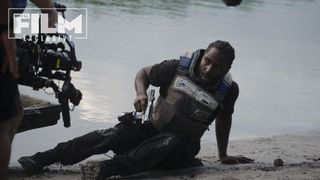
Real science catching up with speculative fancy isn’t the only reason why The Creator feels like a documentary. Another key factor is Edwards’ filmmaking practices, as he sought to take everything he’d learned on Hollywood blockbusters Godzilla and Rogue One, and to meld it with the guerrilla shooting style of his $500,000 debut, Monsters. In that 2010 movie, set six years after an alien invasion, Scoot McNairy’s journalist escorts Whitney Able’s US tourist through an infected zone in Mexico, to the US border. Monsters was shot with digital cameras in Belize, Mexico, Guatemala, Costa Rica and the US, with many of the locations captured without permission. The crew totalled seven people including Edwards and his two leads.
On Rogue One, Edwards experienced studio interference in post-production, and was wary of making such a tentpole movie again. Denis Villeneuve’s Arrival, out the same year as Rogue One, was the space he looked to occupy in future. Costing $47m as opposed to Rogue’s $200m+, it was expensive enough to realise the tremendous vision, but not so pricey as to erode its director’s control. The Creator cost around the $86m mark. ‘If you do a low-budget film, and you write the pros and cons out of having no money, you just swap them over when you do a high-budget film: everything that was easy becomes hard, and everything that was hard becomes easy,’ notes Edwards. ‘So the ultimate goal is, how do you get both things easy? It’s not as simple as just doing a mid-level budget film.’ So what is the secret? ‘We were guerrilla at times,’ says Edwards. ‘We got down to just a few of us. We went to the top of the Himalayas, and it was just me, John David, a camera guy, and Jim [Spencer], who was the line producer on Monsters as well. We didn’t even have sound at times. We went to Indonesia, Nepal, Japan, Cambodia, Vietnam, Thailand. I was really impressed with Oren [Soffer, the DoP who took over from Greig Fraser, his mentor, when Fraser was obliged to shoot Dune: Part Two having won an Oscar for Dune]. Oren’s a real future rising star in the DoP world. He’s super-smart. He’s got a great eye. And I was shooting a lot of the film. I was operating the camera, like I did on Monsters and Rogue One. But Oren would be…’ He pauses to best express it. ‘We wanted 360 – the ability to turn at any point, and see anything. I didn’t want the actors to feel limited.’
‘During the last month-and-a-half of filming, when we were in Indonesia, Cambodia and Japan,’ says Washington, ‘I wasn’t sure if this was a New Regency or Disney-budgeted film or not. I was like, “Is this an indie? Is this a documentary?” In a great, refreshing way.’ The shooting style was freewheeling. ‘We would just go for three minutes at a time, five-minute takes, 10-minute takes, or whatever it took,’ Washington continues. ‘And we would just repeat it. We wouldn’t really reset. We would start and go, start and go, the camera still rolling. It definitely influences you to tell the truth at every moment. Don’t be aware of anything else. It stopped me from listening to myself if a line was wrong, from thinking about if my angle is right, or if I’m hitting a mark.’ Edwards took a novel approach to world-building, going to real countries, real cities, real temples, real beaches, real everything, and then having production designer James Clyne and the ILM digital-effects wizards, led by Jay Cooper, build on top of the footage. It created a naturalistic, lived-in look. ‘I really wanted to start with the actual world,’ nods Edwards, ‘If you do all the conceptual artwork and imagine the world through Photoshop to start with, then what happens is, you end up trying to find places like that, but you can’t. So you have to build them on sets, and you end up with green screen. And before you know it, it feels false. We basically went about this backwards.’
Buildings, weapons, vehicles – all were taken from reality before being married with, and moulded into, different shapes. If the designs didn’t go far enough, it didn’t feel futuristic; if they went too far, it was no longer recognisable. The balance had to be just so. Which isn’t to say there wasn’t elbow room. ‘If you stand in the middle of a village in Thailand, you see some moped from the 1970s that someone managed to keep alive for the last 50 years, right next to an electric car,’ says Edwards. ‘It feels very natural that there’s this mixture of futuristic and past.’
Edwards even applied this organic approach to filmmaking to the simulants in the movie. ‘I wanted the AI to feel very human,’ he says. ‘Basically, the AI in our world believe that they’re real. They feel as 100% alive as everybody else.’ How so? ‘We shot in eight different countries, and we would go to little communities, and shoot scenes in real huts and temples. We never told anybody if they were going to be robots or not. They understood that it was science fiction, and there would be robots, but we never let anybody know who would or wouldn’t be AI, because we didn’t want them to behave differently. And then in postproduction we chose who would be a robot, based on their performance. The more natural they were, the more exciting it was to make that person AI!’ Special-effects supervisor Jay Cooper (Avengers: Endgame, Star Wars: Episode VIII – The Last Jedi) adored working this way, pointing out that employing actual actors is more authentic than using motion-capture performances. ‘If I were to say to you, “All right, I need to sample your motion now. Can you walk from A to B?” You’re going to be a little bit self-conscious about it,’ he says. ‘So the robots are replacements of people who are there on the day.’ And you thought spotting the replicants in Blade Runner was tough.
Size does matter
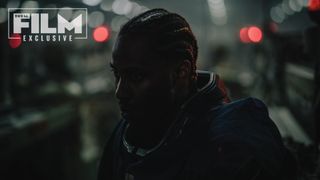
As for spectacle, don’t for one second think that all of this dedication to boots-on-the-ground realism means it’s in short supply. The Creator is huge when it needs to be. ‘We did [virtual on-set production tech] StageCraft,’ says Edwards. ‘We shot a bunch of things that were nearly impossible to film, at Pinewood. It was a really contrasting shoot, because one minute we were on the most expensive soundstage in the world, and then three days later, we were at the top of the Himalayas, three of us.’ It was a shuffling of styles that Washington, a gifted American-football player whose skills can be seen in HBO series Ballers, compares to ‘going from a cold tub to a hot tub and then going back to a cold tub to control the bruise you have’. Even when Washington was walking around remote villages and farms, interacting with the inhabitants, he had to teach them to see things you wouldn’t believe: ‘We gave an actors’ tutorial to these locals, to these farms,’ he says. ‘You know, “If there’s a big spaceship coming, this is how you act.”’
‘We definitely swung for he fences,’ Edwards promises. ‘There’s a giant tank battle in this floating village. We kind of did it for real. There’s this amazing location in Thailand with this giant trestle bridge. It just looked like something from a David Lean movie. And then our special-effects guys shipped in the biggest smoke machine they could possibly get. We had different-sized smoke machines, and that one was referred to as “the giant motherfucker”. When we were filming that [scene], we had loads of extras running and screaming. On camera, it just felt like something from the 70s and 60s – another era of filmmaking. Now everything is usually done digitally with extras and things.’ There’s no copy-and-paste rendering of crowds in The Creator. The huge running laser battle on the beach, which can be glimpsed in the trailer? The production was not allowed to close the beach so it just rocked up and filmed, with extras as far as the eye could see. ‘The goal was to have it feel like the kind of movies that we grew up loving,’ Edwards says. ‘If anything, our future is based on what we felt the future would look like from when we were in the 80s, rather than it all being this slick, Apple Mac version of the future. We wanted it to be more like a Sony Walkman, or a Nintendo, version of the future.’
When Total Film talks with Washington, he’s fresh from seeing the finished film for the first time. He’s wowed, struggling to find the words to best describe it. He talks of the ‘scope’ and the ‘collision of beauty and violence’, before settling on ‘emotional’ to best sum it up. The actor compares Edwards with Tenet director Christopher DISNEY Nolan, in that they like to involve everyone in the process, they care about every detail, and they fashion enormous, immersive spectacles. As for Edwards, he still can’t quite believe that he got to make it. And his way. ‘Honestly, it’s been great,’ he beams. ‘New Regency deserve a medal for having the balls to do original genre filmmaking. I think we’re one of the few, if not the only big movie out this summer, that’s not based on a book or an IP or a franchise. It’s kind of insane that it’s got to that point. The fact that they were willing to make this movie was incredible. And they really did back me as a filmmaker the entire way. They were fantastic.'
Edwards’ mind turns to the movies of Steven Spielberg, who, like Cameron, is one of his gods. What Spielberg does better than anyone is those moments of anticipation, of eye-widening reveal. ‘What cinema can do that books can’t do, or plays, is it can give you that goosebump kind of awe and wonder. I feel like the two key phrases that were said the most while we were making The Creator were “epic” and “emotional”. If you can get something that’s epic and also emotional, then that’s the holy grail of filmmaking.’
The Creator is out in UK cinemas now and US theaters from September 29. For much more from Total Film, make sure to subscribe to the magazineand never miss another world-exclusive feature.
Jamie Graham is the Editor-at-Large of Total Film magazine. You'll likely find them around these parts reviewing the biggest films on the planet and speaking to some of the biggest stars in the business – that's just what Jamie does. Jamie has also written for outlets like SFX and the Sunday Times Culture, and appeared on podcasts exploring the wondrous worlds of occult and horror.
Most Popular







